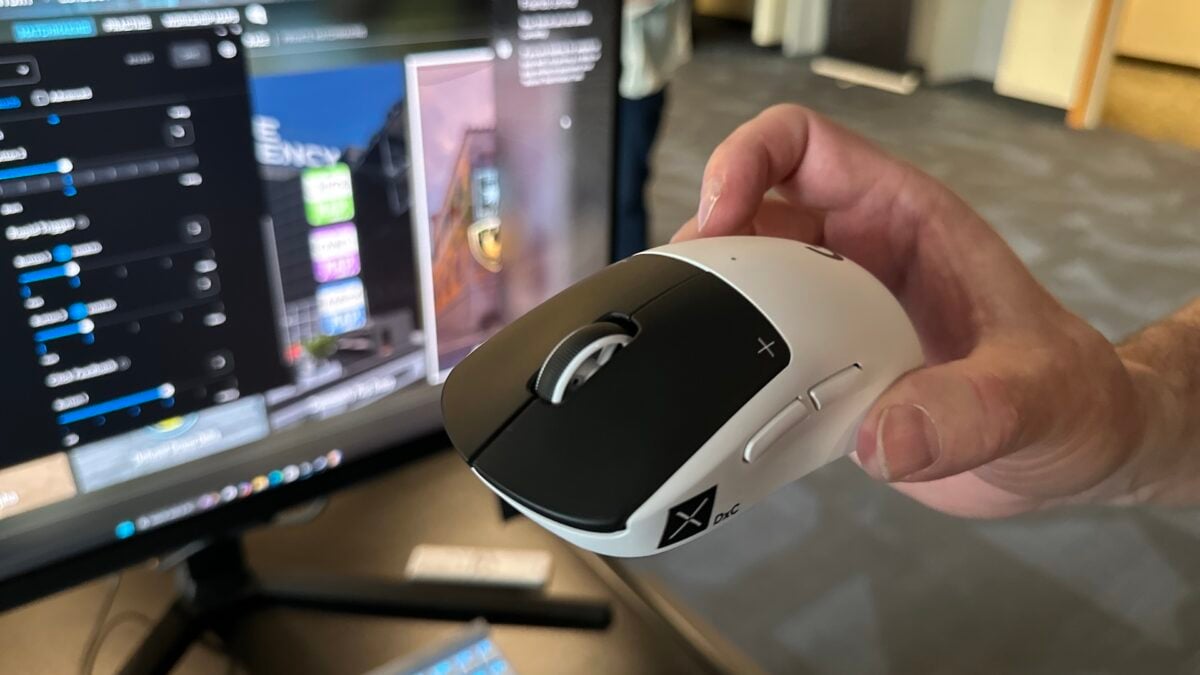
Logitech’s race to offer an esports mouse with the fastest response time has led us to a mouse that’s completely different than any I’ve used before. Mice have relied on the same type of microswitches for their button clicks for so long, it’s hard to imagine what would be next. So I didn’t know what to think when I sat down in front of the $180 Logitech G Pro X2 Superstrike mouse that doesn’t “click” in the traditional sense. Instead, it uses haptics to offer a facsimile of the classic click sensation.
The G Pro X2 Superstrike mouse is bespeckled in enough “X” and “+” decals that I imagined I was looking at some off-the-line prototype, which to a certain extent it was. The G Pro X2 Superstrike uses what Logitech dubs its “Haptic Inductive Trigger System,” a name that breaks down into the groan-inducing acronym “HITS.” The mouse uses a set of copper coils creating an electromagnetic field—akin to modern keyboards with Hall effect switches—to detect when users press down on its buttons. This type of inductive analog sensing can determine the click travel—aka the depth the button moves—through up to 10 actuation points and five reset points. Logitech claims this offers 30-milliseconds lower latency than an optical mouse switch—which uses a beam of infrared light to determine when you click in a mouse button.
This new type of mouse “click” also introduces the “rapid trigger” function common on keyboards. This feature makes multiple inputs in quick succession. Optical switches already have to use some trickery to offer some of the same clicky sensation of a mechanical mouse switch, such as Logitech’s own “Lightforce” switches found in the company’s other mice, like the Pro 2 LIghtspeed and Pro X Superlight 2. The G Pro X2 Superstrike instead relies on “real-time click haptics” to offer the feel of a click when you press the button and when the key resets. I spent a few minutes clacking away on an early prototype model, and I found the sensation is still very different from either a mechanical or optical mouse switch. It’s less bouncy than even the silent switches you’ll find in productivity mice like Logitech’s MX Master 3S. The peripheral maker told me users will be able to adjust the intensity of the haptic click in the G Hub app.
Users will be able to customize those actuation and reset points as well. Esports players may get a kick out of setting up their own actuation points, but I can’t imagine the vast majority of gamers will want to sit down and fine-tune their mouse click and click haptics until it reaches Goldilocks levels of “just right.” If we judged the Logitech G Pro X2 Superstrike by its other specs, it would be more of the same. It’s using the Logitech G Hero 2 sensor with an 8,000Hz polling rate—measuring how often the device sends information to the computer. It boasts a 44k DPI—which measures the mouse’s potential sensitivity.
Logitech says the G Pro X2 Superstrike weighs 65g, which would make it one of the company’s lighter gaming mice to date. The company also claims it can get 90 hours of battery life from one charge. The one thing Logitech’s latest has over other mice is that it’s compatible with the G Powerplay 2 mousepad, which offers continuous charge to the mouse’s battery. I’ve been operating on Razer’s 56g Deathadder V4 Pro wireless gaming mouse for testing PCs. It’s such a streamlined device with redesigned optical switches meant to reduce actuation and latency. Razer’s device minimizes latency with a separate wired HyperSpeed Wireless Gen-2 dongle promising just under 0.3ms average latency.
Logitech’s new mouse should be available sometime early in 2026 for $180. Whether it will be the true future of ultra-fast mice, I’ll need more time with it to see if I can actually get used to a mouse with a fake click.



